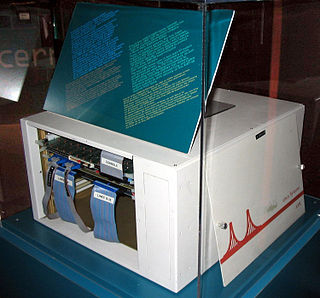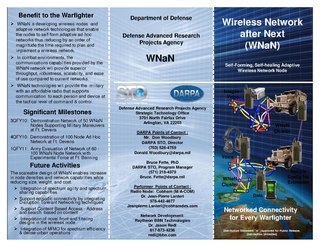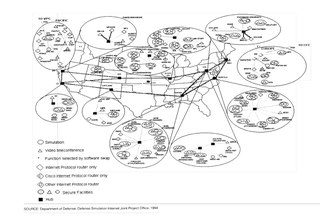The Internet protocol suite is the conceptual model and set of communications protocols used in the Internet and similar computer networks. It is commonly known as TCP/IP because the foundational protocols in the suite are the Transmission Control Protocol (TCP) and the Internet Protocol (IP). During its development, versions of it were known as the Department of Defense (DoD) model because the development of the networking method was funded by the United States Department of Defense through DARPA.

A router is a networking device that forwards data packets between computer networks. Routers perform the traffic directing functions on the Internet. Data sent through the internet, such as a web page or email, is in the form of data packets. A packet is typically forwarded from one router to another router through the networks that constitute an internetwork until it reaches its destination node.

Packet switching is a method of grouping data that is transmitted over a digital network into packets. Packets are made of a header and a payload. Data in the header are used by networking hardware to direct the packet to its destination where the payload is extracted and used by application software. Packet switching is the primary basis for data communications in computer networks worldwide.
The end-to-end principle is a design framework in computer networking. In networks designed according to this principle, application-specific features reside in the communicating end nodes of the network, rather than in intermediary nodes, such as gateways and routers, that exist to establish the network.
BBN Technologies is an American research and development company, based next to Fresh Pond in Cambridge, Massachusetts, United States.

The Advanced Research Projects Agency Network (ARPANET) was an early packet-switching network and the first network to implement the TCP/IP protocol suite. Both technologies became the technical foundation of the Internet. The ARPANET was initially founded by the Advanced Research Projects Agency (ARPA) of the United States Department of Defense.

Robert Elliot Kahn is an American electrical engineer, who, along with Vint Cerf, first proposed the Transmission Control Protocol (TCP) and the Internet Protocol (IP), the fundamental communication protocols at the heart of the Internet.
The Internet Stream Protocol (ST) is a family of experimental protocols first defined in Internet Experiment Note IEN-119 in 1979, and later substantially revised in RFC 1190 (ST-II) and RFC 1819 (ST2+). The protocol uses the version number 5 in the version field of the Internet Protocol header, but was never known as IPv5.
The BBN Butterfly was a massively parallel computer built by Bolt, Beranek and Newman in the 1980s. It was named for the "butterfly" multi-stage switching network around which it was built. Each machine had up to 512 CPUs, each with local memory, which could be connected to allow every CPU access to every other CPU's memory, although with a substantially greater latency than for its own. The CPUs were commodity microprocessors. The memory address space was shared.
The Interface Message Processor (IMP) was the packet switching node used to interconnect participant networks to the ARPANET from the late 1960s to 1989. It was the first generation of gateways, which are known today as routers. An IMP was a ruggedized Honeywell DDP-516 minicomputer with special-purpose interfaces and software. In later years the IMPs were made from the non-ruggedized Honeywell 316 which could handle two-thirds of the communication traffic at approximately one-half the cost. An IMP requires the connection to a host computer via a special bit-serial interface, defined in BBN Report 1822. The IMP software and the ARPA network communications protocol running on the IMPs was discussed in RFC 1, the first of a series of standardization documents published by the Internet Engineering Task Force (IETF).
The Defense Data Network (DDN) was a computer networking effort of the United States Department of Defense from 1983 through 1995. It was based on ARPANET technology.
SIMNET was a wide area network with vehicle simulators and displays for real-time distributed combat simulation: tanks, helicopters and airplanes in a virtual battlefield. SIMNET was developed for and used by the United States military. SIMNET development began in the mid-1980s, was fielded starting in 1987, and was used for training until successor programs came online well into the 1990s.

A computer network is a digital telecommunications network which allows nodes to share resources. In computer networks, computing devices exchange data with each other using connections between nodes. These data links are established over cable media such as twisted pair or fiber-optic cables, and wireless media such as Wi-Fi.
The following outline is provided as an overview of and topical guide to the Internet.

The Packet Radio Network (PRNET) was a set of early, experimental mobile ad hoc networks whose technologies evolved over time. It was funded by the Advanced Research Projects Agency (ARPA). Major participants in the project included BBN Technologies, Hazeltine Corporation, Rockwell International's Collins division, and SRI International.

The Wireless Network after Next was a DARPA project to create and demonstrate an advanced tactical mobile ad-hoc network that rapidly adapts to soldiers maneuvering in complicated environments, automatically determining the best radio frequencies and network path to maximize connectivity and throughput. In 2010 it was successfully demonstrated in live military experiments containing up to 100 nodes, the largest military MANET demonstrated to that date.

The Defense Simulation Internet (DSI) was a specialized, wide-area network created to support Distributed Interactive Simulation and videoconferences. It was sponsored by DARPA, and built and operated by BBN Technologies from about 1991-1995, after which time it was operated by the Defense Information Systems Agency (DISA).

The ARPANET pioneered the creation of novel encryption devices for packet networks in the 1970s and 1980s, and as such were ancestors to today's IPsec architecture, and High Assurance Internet Protocol Encryptor (HAIPE) devices more specifically.

The DARPA Quantum Network (2002-2007) was the world's first quantum key distribution (QKD) network, operating 10 optical nodes across Boston and Cambridge, Massachusetts. It became fully operational on October 23, 2003 in BBN's laboratories, and in June 2004 was fielded through dark fiber under the streets of Cambridge and Boston, where it ran continuously for over 3 years. The project also created and fielded the world's first superconducting nanowire single-photon detector. It was sponsored by DARPA as part of the QuIST program, and built and operated by BBN Technologies in close collaboration with colleagues at Harvard University and the Boston University Photonics Center.










